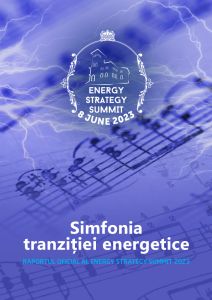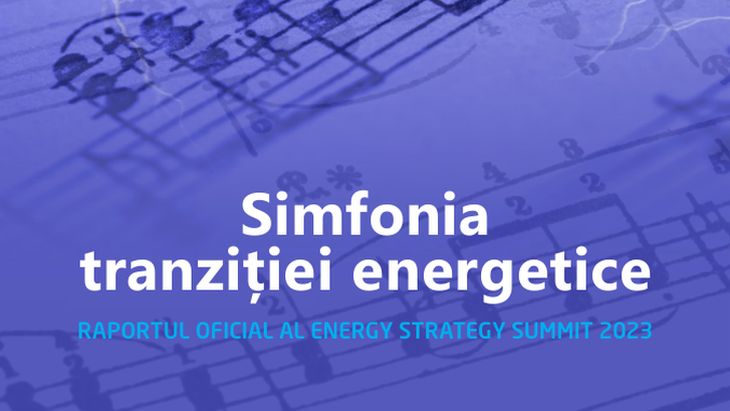For the energy transition to succeed, all relevant actors need to be involved. At present, the Romanian energy industry is like an orchestra preparing to perform a large symphony in which each instrument plays a key role. Each component must synchronize and play its score (strategy) so that we have a smooth and successful transition to sustainable energy sources. The 9th edition of the Energy Strategy Summit (follow-up articles) was an excellent opportunity to explore the energy industry in Romania and highlight the main challenges facing each sector.
Overture

The future will be electrification and digital because these two elements are inseparable, and the goal of this energy transition towards non-polluting energies must be to increase the benefits for society, said Gabriel Tache, Country Sales Manager at Eaton Romania. Răzvan Encică, Managing Director at Phoenix Contact Romania added that „ the society of the future is an electric society and in the new context it will be necessary for the entire energy chain to be interconnected, which can only be achieved through automation and digitization”. He also highlighted a significant impediment – the lack of skilled labor in the sector.
All speakers stressed that Romania needs to capitalize on the advantage of having a diverse and balanced generation sector, in which the main energy sources currently used, such as coal and natural gas, hydro and nuclear, will continue to play an important role.
Renewable energy sources set the tone
The energy transition has already been taking place for more than 20 years, ever since Germany began to heavily subsidies its solar and wind installations, claimed Cristian Pîrvulescu. According to him, now is the time to establish measures aimed at activities downstream of renewable sources, namely more automation, because the energy market has become democratized and is no longer controlled by large utility companies. “The new actors in the energy market are malls, agricultural producers, factories and industry, and their number will increase as more and more public institutions, residential complexes and buildings will be required to mount photovoltaic panels on their roofs. The energy deficit was not covered by classical sources, but by renewable energy, because in 2022 the European Union installed more wind turbines, heat pumps and photovoltaics than it did in its entire history. The conclusion is that the subsidies and the war accelerated the energy transition”, Pîrvulescu added.
Romania’s target of having at least 10 GW of new low-carbon renewable energy production units by 2030 is likely to be exceeded given the effervescence in the market and investor appetite, which equates to a new industrial revolution. At the same time, Romania also competes with other countries for investors’ investments, so it will have to carefully exploit its chances and opportunities, said Varinia Radu, founder and managing partner of Energynomics. Of the 10GW, 2GW of capacity is to be realized in the next two years and a further 3GW by 2025, said Elena Popescu, Director General of the General Policy Directorate Energy and Green Deal from the Ministry of Energy. “This is also a milestone in the NRRP and we are forced to conclude contracts for 1,500 MW this year. This year there will be an auction [through the contract for difference scheme] for 2 GW and another in 2025 for 3 GW, announced Popescu. On the Modernization Fund alone, 5.3 billion euro of schemes are currently initiated, contracts signed and schemes approved, said Dan Drăgan, and through the NRRP we could soon sign contracts for renewable and cogeneration (CHP) projects of almost 1 billion euro.
Electrica SA plans to invest in several electricity generation capacities with a cumulative power of 1 GW until 2026, of which 400 MW projects are under implementation already, said the company’s general director Alexandru Chiriță. Agriculture and industrial production are the economic sectors most interested in investing in their own capacity to generate energy from renewable sources in order to optimize their costs and protect their profit margins, said Alexandra Floricică, Head of Green Energy at ProCredit Bank Romania.
A study carried out earlier this year by the engineering company ABB reveals that more than 92% of companies believe that energy security and the price of electricity are the factors that most influence their decisions to invest, said Constantin Ichimoaei, Executive Manager at ABB România. Also, the ESG requirements created, for the first time, a link between the objectives of private companies and the authorities, and thus could create the conditions for better communication between the two parties, said Răzvan Copoiu, CEO of Signify SEE Europe. “ESG is the new black. You have to protect the planet while also making a profit, this is a performance indicator that can be tracked by both private companies and the government side. We notice that it is like a letter of the law that will apply everywhere […]”, said Copoiu.
Countertheme: Barriers against RES
Renewable energy is becoming the largest investor in the energy sector, with an estimated contribution of 30-40 billion euros in 2050, but the lack of labor can be an obstacle in the development of projects, said Lăcrămioara Diaconu-Pințea, Country Manager of OX2 Romania. In turn, Ionuț Ciubotaru, Vice President of Business Development at OMV Petrom, stated that in Romania, there are no companies that can build photovoltaic parks larger than 50 MW, and many projects already built have many deficiencies. Even more, poor projects hinder the development of good green energy projects, Radu Tărău, Executive Director of EnergoBit Control Solutions warned. ” There are many projects, but their quality is very diverse and there are few developers who develop a project correctly. […] Only we have projects with technical approvals for the connection of 7 GW. We are assailed from all sides both on the planning side and on the execution side. […] I think we need to have some quality criteria so that good projects can be executed because there is an appetite from investors”, said Tărău. One of the biggest mistakes of the beneficiaries of photovoltaic plants is that they refer first of all to the price and the implementation period and only then to the quality of the works. The high number of non-compliant projects can jeopardize investments in the sector, Adrian Săcuiu, Managing Partner la Volt, signaled.
The delay with which the authorities manage to evaluate the multitude of renewable energy projects and the lack of specialists among designers and developers endanger the absorption of European funds allocated to the energy sector, said Roxana Mircea, Managing Partner at REI Grup.
Dan Fleșariu, CEO Wiren, mentioned two of the trends for the coming years: photovoltaics on tall buildings and energy storage. According to him, there is already increased developer interest in installing solar panels on high-rise buildings as the stock of existing buildings depletes, as well as a need for renewable energy storage as a result of difficulties in injecting electricity into the grid, because of the accelerated increase in the number of prosumers.
Harmony through synchronization of technological solutions
CEZ Romania is prepared to increase the annual level of investments in the energy distribution area to 700-800 million lei in order to cope with the pace imposed by the energy transition, said Ondrej Safar, country manager at CEZ Romania. ”Starting next year, we believe it is necessary to raise the level of investments to 700-800 million lei per year, funds that will come from our own financing, bank loans and EU funds. […] However, we see that there is also the huge risk of not having which companies to make these investments with, nor enough equipment,” said Safar.
In this respect, WIKA Group, active in the field of measurement technology for the past 77 years, is focusing on three main mega trends that are part of the energy transition: decarbonisation, digitalization and decentralization, we learned from Sorin Balasko, Senior Vice President Eastern Europe, WIKA Group. There are companies such as Huawei, which offers a range of power generation equipment, including digital power products to support this new wave of renewable energy. Mihai Popescu, Product Manager at Huawei Romania, presented solutions for energy storage and electric vehicle charging.
From this perspective, Claudia Griech, General Manager of E.ON Energie Romania, recalled that the number of electric cars in Romania reached 30,000 units this year, compared to 6,000 three years ago, and by 2030 it could reach 200,000 units. Charging them will require a network of at least 60,000 electric charging points, she estimated.
Many companies have started to take into account the refurbishment of some of the wind farms installed 10-14 years ago, as they are starting to approach the end of their life, said Liviu Gavrilă, vice president of RWEA. A complementary solution is to use technologies and equipment that are currently unused to increase the efficiency of ongoing operations, explained Elena Popescu, CEO of Elektra Renewable Support.
A suggestion for an integrated approach came from Adrian Paraschiv, Country Manager of Photomate, who advocated that Romania’s energy strategy must include not only the component of energy production from renewable sources but also solutions for its use for the manufacture of goods with high added value. The energy produced from renewable sources will have to be stored to be used at times of consumption peaks but will also have to be used in those industries that need it during the day. A complete circuit is needed, from the investor in energy production, through suppliers, the energy transporter, distributors and up to the final consumer and the production of a finished product with high added value that Romania can export.
Controversial solo: phasing out fossil fuels
Several speakers highlighted the challenges related to the current dependence on fossil fuels and their role in the transition to cleaner energy sources. Natural gas is the main element on which the energy transition should be based, as it is a fuel that can be used immediately and with quick effects in terms of reducing carbon emissions, said Ionuț Ciubotaru. A first argument is that using gas instead of coal immediately reduces carbon emissions using existing technologies. Secondly, achieving energy neutrality requires industry and consumers to change their technologies, which is costly and uncertain because there are no mature technologies that use any fuel other than natural gas. “Thus, natural gas can ensure the use of existing technologies at least for a while, thus giving time for the emergence of new ones. In addition, gas can potentiate the development of the hydrogen economy in both the generation and transportation areas, and such tests are underway in Romania and other countries.” Last but not least, know-how from the gas industry can also be used in the area of carbon storage and capture, he added.
In this respect, Romania is in a privileged position because it has natural gas resources, said Manuela Trișnevschi, Head of Energy & Utilities at BCR: “We have the capacity to build large renewable energy units, but we also have the gas, which we can use during the transition period,” she said.
Crescendo through policies and regulations
In the Decarbonization Strategy, which was recently sent to the European Commission, Romania chose the most optimistic scenario, reaching climate neutrality by 2050, and how well the new targets can be reached will be reflected in the new Integrated National Plan for Energy and Climate Changes (NEPC), whose revision will be ready in a few months, said Elena Popescu (the Ministry of Energy). “The Commission came with clear guidelines and requests, we have 23 annexes to complete, which reflect the implementation stage for each sector and these annexes, completed, will reflect the situation at the sectoral and national level”, she explained. Antal Lorant, Chairman of the Senate Committee on Energy, Energy Infrastructure and Mineral Resources, reviewed some of the regulations debated and approved by the committee he chairs. According to Antal, “the most important move” was the Parliament’s modification of the Offshore Law, which basically paved the way for investors OMV Petrom and Romgaz to start extracting natural gas from the Neptun Deep perimeter in the Black Sea. By amending the Land Fund Law, the commission created a simplified method of authorizing photovoltaic parks without PUZ for agricultural land areas smaller than 50 hectares, but the possibility of investors having access to capacities greater than 50 MW or 50 of hectares. He also said that Romania is the first country in the European Union to vote for the “law of the future”, i.e. the hydrogen law, which paved the way for the hydrogen treaty process and its use mixed with natural gas.
The score is here, who conducts the orchestra?
Romania will need more and more energy as it develops and the level of prosperity increases, but the challenge is for that energy to have as little carbon footprint as possible, said Christina Verchere, CEO of OMV Petrom. As in the rest of the European Union, all energy companies in Romania have created energy transition plans, and “in the last two years it has become clear that the energy transition must also mean energy security, as well as affordable energy prices”. Romania now has the score and all the necessary instruments to make the energy transition a harmonious symphony.
We have the money, but the tempo for accessing it may not be right for investors. We have investments in distribution and transmission networks, but these may not be in accord to the new power generation projects. “And we need people, which is why we also need academia to support this whole effort,” added Lăcrămioara Diaconu-Pințea, reinforcing the call made by Radu Dudău, co-founder and director of the Energy Policy Group: “We need qualified people in all fields and at all skill levels.”
Romania needs to bring together all the elements that determine a successful performance: “All the players in the industry and each sector must play their part in harmony” (Lăcrămioara Diaconu-Pințea).

